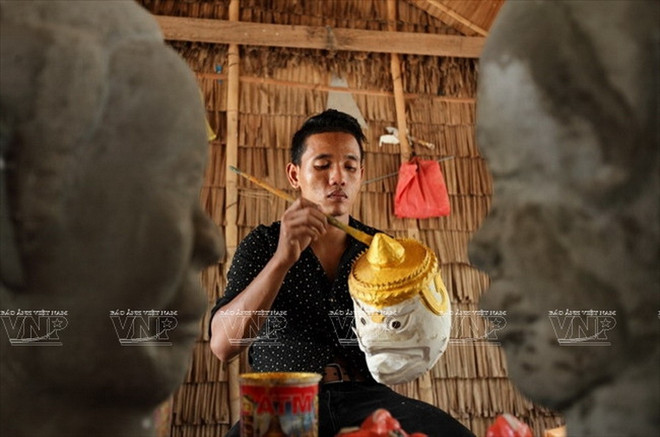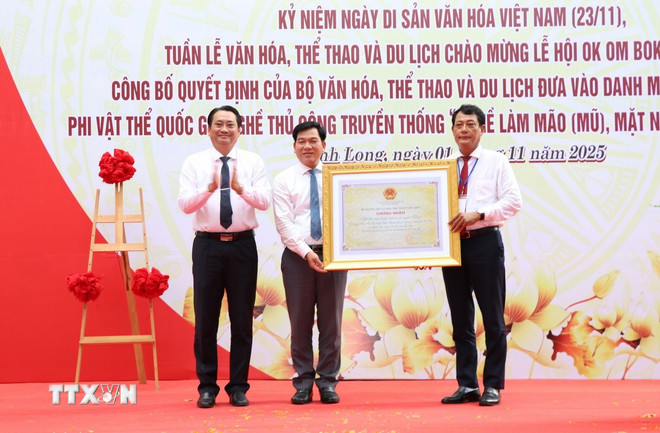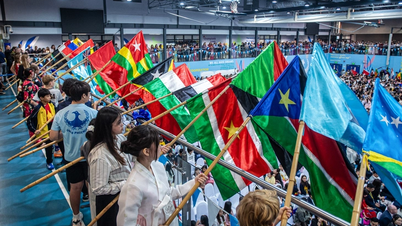Through the development process, the Khmer people in Vinh Long province (formerly Tra Vinh province) have accumulated a rich treasure of folk cultural knowledge.
In the traditional performing arts and dances of the Khmer people, hats and masks are two special types of costumes imbued with mystery and sacredness, imbued with the traditional culture of the Khmer people, demonstrating the artistic level and folk knowledge of the ethnic group.
According to senior artisans, the craft of making crowns and masks appeared in Vinh Long (formerly Tra Vinh province) hundreds of years ago. This is a traditional craft that goes hand in hand with the development of Khmer performing arts such as folk dance, traditional dance, religious dance and opera.
The images of crowns and masks worn by each character are the identifying features of each dance and are symbols with a certain meaning. Through that, they convey profound meanings, expressing the belief in good triumphing over evil, justice overcoming cruelty, and the transformation and direction of goodness to bring good things in life.
The labor process is completely manual, meticulous and skillful to create durable, beautiful products, full of artistic creativity. Through ups and downs, the craft has become a precious cultural heritage, passed down from generation to generation, responding to the most popular art forms such as Chhay dam drum dance, Ro bam dance drama and Du Ke stage; contributing to creating a colorful cultural picture of the Mekong Delta.
To complete a crown or mask, an artisan must go through dozens of stages including: creating a mold, selecting and processing materials, extracting and mixing adhesives, gluing, drying, separating the mold, joining, grinding, editing, painting, drawing, applying patterns and finally attaching orange petals, sequins, and decorative beads.
To create crown and mask molds, artisans often use soft clay to knead, shape the head and details of eyes, nose, mouth, ears... then dry them. After the mold is dry, the maker will use cloth (curtain or coarse fabric cut into small pieces about 5x7cm) or cardboard, newspaper dipped in glue and stick it on the clay mold.
The glue here can be taken from the sap of green hop fruit (similar to the tamanu fruit, a local tree) or using glue or industrial glues.

Cloth or paper is usually applied in about 8 to 12 layers to create a certain thickness and hardness for the crown or mask. After applying the cloth or paper, people dry the layers of cloth or paper until they stick together firmly, then break off the clay mold inside. Thus, a rough crown or mask is obtained.
Nowadays, many artisans often use cement to create molds, this method has the advantage of being able to reuse the mold many times. However, when making a mold with cement, a small groove must be cut around both sides of the ear or from the front of the face to the back, so that when the process of covering the fabric or gluing the paper is finished, a knife can be used to cut along this groove to take out the crown and sew the two parts together. Then proceed to paint and draw decorative patterns on the crown and mask.
The crown itself must also undergo the process of shaping the top of the head, then decorating with patterns and painting with colors. Depending on the character being created, such as the ogre, Hanuman the monkey, the queen, the princess, the clown, etc., the artisan must adhere to specific standards of shaping, color, and pattern.
The makers of crowns and masks are required to have a deep understanding of Khmer culture, only then can they create standard products that express the character's spirit and nature.
The steps to make a product are completely manual and must be very careful and meticulous in every small detail. Depending on the type of crown, mask simple or complex, the completion time is also different.
Artisans mainly only work when customers request or during traditional Khmer holidays and New Year.
These types of crowns and masks are often used in traditional Khmer festivals and holidays such as Chol Chnam Thmay, Ok Om Bok festival, Don Ta festival... or performed in traditional Khmer art forms such as Ro bam dance, Chhay dam dance, Aday singing, Du ke singing.

With its unique and distinctive values, the Khmer people's crown and mask making profession was recognized as a National Intangible Cultural Heritage on June 27, 2025.
On November 1, 2025, at the celebration of Vietnam Cultural Heritage Day in conjunction with the Culture, Sports and Tourism Week celebrating the Ok Om Bok Festival 2025 taking place in Nguyet Hoa ward, the province, the Department of Culture, Sports and Tourism of Vinh Long province announced the decision of the Ministry of Culture, Sports and Tourism on including the handicraft "Mao (hat) and mask making of the Khmer people" in the List of national intangible cultural heritage.
Speaking at the ceremony, Vice Chairman of the Vinh Long Provincial People's Committee Nguyen Quynh Thien requested the Department of Culture, Sports and Tourism of the province and relevant levels and sectors to strengthen information and propaganda work on the significance and importance of heritage in the local socio-economic development; develop a project to preserve and promote the value of the Khmer people's crown and mask making profession, and link tourism development programs with manufacturing facilities to spread heritage values.
At the same time, the units regularly organize a variety of practical activities and vocational training; research, select, and propose to award honorary titles to artisans./.
Source: https://www.vietnamplus.vn/doc-dao-nghe-lam-mao-mat-na-cua-nguoi-dan-toc-khmer-o-vinh-long-post1075132.vnp







![[Photo] Da Nang: Hundreds of people join hands to clean up a vital tourist route after storm No. 13](https://vphoto.vietnam.vn/thumb/1200x675/vietnam/resource/IMAGE/2025/11/07/1762491638903_image-3-1353-jpg.webp)







































































































Comment (0)